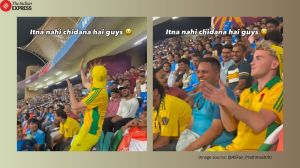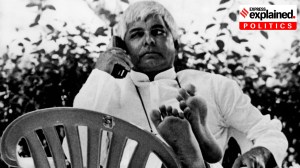The bass female playback voice is receiving long-overdue credit. But is the shift still superficial?
Deep female playback voices in Hindi cinema were once considered liberated, dominating and unshackled by the burdens of society, which is why they were not used for the lead female character
 Kolkata-based vocalist Barnali Chattopadhyay sang for Sanjay Leela Bhansali's Heeramandi.
Kolkata-based vocalist Barnali Chattopadhyay sang for Sanjay Leela Bhansali's Heeramandi.When filmmaker Sanjay Leela Bhansali was looking for the singing voice of Bibbojaan, played by actor Aditi Rao Hydari in Heeramandi: The Diamond Bazaar — a character based on Kanpur’s Azeezan Bai, a courtesan who helped the Indian rebel forces in 1857 — he got Kolkata-based vocalist Barnali Chattopadhyay into his recording studio in Mumbai’s Juhu.
According to Chattopadhyay, Bhansali was looking for a voice that was not only classically trained in thumri — which she had imbibed under the tutelage of the form’s foremost names: Shobha Gurtu and Girija Devi — he also wanted a voice that suited the milieu: Lahore of the ’30s and ’40s and the world of courtesans. The result of their collaboration is the coquettish ‘O sayiyaan hato jao’, a thumri set in Vrindavani Sarang, the afternoon raga with dreamy romance at its core. Chattopadhyay has sung it using the strength and throw of her voice to delightful effect. Interestingly, her voice is neither thin and saccharine, nor does it come with a high-pitched timbre. It isn’t the traditional patli awaaz with a brooding sweetness often preferred by Bhansali and other filmmakers for their dewy, gentle heroines. “If you notice, Aditi also speaks in a husky tone. And she is playing a courtesan from an older time. So Mr Bhansali, who does everything very carefully, chose my voice to suit her style,” says Chattopadhyay, who has also rendered a version of the age-old ‘Phul gendwa na maro’, once sung by Rasoolan Bai as a song of desire. Bhansali turned it into a piece for the brokenhearted in his eight-part series. With these two songs, Chattopadhyay has managed to pull off the sensuous as well as the melancholia in her robust bass voice for an actor who looks dainty and is trying to present nazaakat on screen.
Deep female playback voices in Hindi cinema were once considered liberated, dominating and unshackled by the burdens of society, which is why they were not used for the lead female character. In a soundscape that was dominated by the two phenomenal Mangeshkar sisters — Lata, the voice of the righteous heroine and Asha, voice of the vamp for years until her ghazals found much success, bass voices weren’t in demand, even though Hindi cinema had begun with thicker voices like that of Begum Akhtar, Zohrabai and Shamshad Begum for lead protagonists.
It was Lata’s arrival on the scene with a classical idiom mixed with a veneer of innocence that resulted in a voice that the country fell in love with. The awe was mutual on both sides of the border. While they loved the versatility of Geeta Dutt, Lata had them overwhelmed. But even ‘Aayega aanewala’, Lata’s watershed moment in Hindi cinema, was sung in a deep, slightly nasal voice, as the singer was inspired by Noorjehan. But she shifted gears soon, becoming the voice of the coy and chaste heroine by singing in a softer, thinner timbre. The thicker voices were relegated to the background.
Hindustani classical vocalist Shubha Mudgal, whose own tonal range is in the lower register and moves liberally in that space, believes that Hindi cinema, very often, believes in cliches. “When a heavier voice has been used, it’s either in the background (and not in the playback), or for the bad girl variety, or the banjaran – that tragic jogan, who is lonely and is pouring her heart out in anguish. Here you’d hear the voice of, for example, Reshmaji. I feel those roles became reserved for those voices,” says Mudgal, who, besides Hindustani classical concerts, has also dabbled in indie music and songs in films like Raincoat (2004), Laaga Chunari Mein Daag (2007) and Aparna Sen’s Goynar Baksho (2013) among others.
Mudgal, who never found the Hindustani classical world biased towards any particular timbre while learning, adds that since some of the most significant higher-pitched voices have been of the prodigious Mangeshkar sisters, who had the ability to translate any composer’s music, “and I am not saying that singers with heavy voices cannot… the standards that they set, perhaps had a lot of people try and sing like them,” she says.
So when she heard Usha Uthup sing the tender and flirtatious ‘Bindiya chamkegi’ (Do Raaste, 1969) in her hefty and hearty voice at a Lata Mangeshkar tribute concert in Kolkata in 2022, she was dazzled by the spunk that Uthup brought to the song. “Lata ji’s voice sounds beautiful in that song which has a certain mischief and thumka in it. But it was an absolute treat to listen to Usha render this piece,” says Mudgal. Interestingly Uthup, one of the few Hindi cinema singers with a big bass voice, sang some distinctive numbers but almost never to emote delicate bhaav.
As films moved to less formulaic tropes, directors also looked for characters who spoke like normal people. As cinema evolved, the singing styles evolved too. The composers were now looking for different textures and not for every female actor’s voice to sound the same. Soon one saw Ram Sampath work with whiskey-voiced Suman Sridhar, who sang the groovy ‘Muskaane jhoothi hain’ in Talaash (2003) followed by Sona Mohapatra crooning the rakish and fantastic ‘Bedardi raja’ (Delhi Belly, 2011). Rekha Bhardwaj, who appeared on scene when Alka Yagnik was singing almost every other song in her soprano voice, took a while before finding success with ‘Namak’ (Omkara, 2006) and ‘Sasural genda phool’ (Delhi 6, 2009). Composer Mithoon brought in Shilpa Rao to sing the heady ‘Tose naina’ in Anwar (2007), and had a male singer sing the higher parts. Rao has gone on to sing hits such as ‘Khuda jaane’ and ‘Besharam rang’ for Deepika Padukone in recent years.
Around the same time the films and composers were evolving, composer Pritam, too, was looking for a different voice and came across Shefali Alvares. She sang ‘Ye dil hai nakhrewala’ and a massive club hit like ‘Tu mera hero’ for him. But Alvares didn’t see Bollywood as her space. For someone who heard and sang tunes by Stevie Wonder, Chaka Khan and Sting, she never thought she would fit in. “I still don’t fit in,” says Alvares with a laugh. “But I do see the power of what film music does to the audience,” she says.
Alvares feels that the boxing up of voices in neat little compartments is happening even now but in a different way. “You get stuck in a certain kind of voice. At this point Nikita Gandhi is the voice that everyone is preferring to use, earlier it was Sunidhi (Chauhan), but certain things are now Neeti Mohan. Then there are certain songs for which you will only call Shreya, and no other singer. Even now, it’s all boxed,” says Alvares, who feels that the OTT space has brought about some change. “Films and web series are now more open to newer ideas and voices,” she says.
Mudgal feels that the change is still very superficial. A woman singer with a heavy voice, she says, is still not acceptable either to the film director, to the music director or sometimes even the powerful labels. Like Alvares, she says that the slotting is always for a particular kind of character. “Even in Mr Bhansali’s case, these are thumris and dadras being sung in the ‘badnaam basti’ of Heeramandi. Shreya Ghoshal sings for Alamzeb, the sweet, gentle character, even though the actor portraying her actually has a heavy speaking tone. And Shreya (Ghoshal) is a phenomenal singer. But it’s with the sweet girl that the thick-voice experiment is still not done easily,” says Mudgal.



- 01
- 02
- 03
- 04
- 05



























